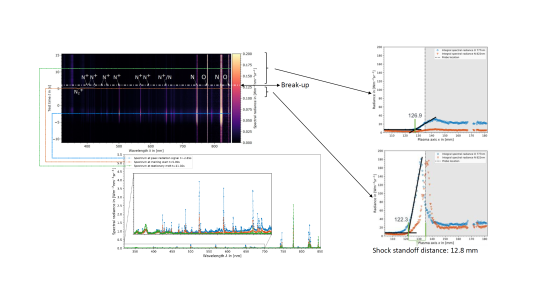Spectrographic response of break-up fragments to the re-entry environment
Programme
TDE
Programme Reference
T711-602SD
Prime Contractor
FLUID GRAVITY ENGINEERING LTD
Start Date
End Date
Status
Closed
Country
United Kingdom

Objectives
To use the full potential of spectrographs for atmospheric re-entry of spacecraft by means of a paradigm shift to identify the structure's radiative response to the environment
Description
The few spectroscopic re-entry break-up observation campaigns which have taken place focused on data collection for meteoroids and space systems equipped with thermal protection shields. Those techniques perform well within their intended scope, but are not fully suited for analysing the re-entry of general artificial objects. ESA supported such data collection on ATV-1, Cygnus-OA6, and WT1190F via these methods but interpretation has been difficult.
Preliminary analysis of those datasets, in combination with on-ground material characterisation tests, indicated that di- and tri-atomic molecules significantly contribute to the observed spectra and can thus greatly extend our interpretation of break-up phenomenology. The focus so far has been on how materials and structures demise during re-entry, but not which verifiable consequences this produces in flight or how the expected behaviour can be confirmed when a component is designed with a specific demise pattern in mind. As numerical simulations of spacecraft break-up suffer from large uncertainties, and on ground testing is limited to small component sizes and can't be physically fully representative, this activity aims at filling the gap.
In this activity, the occurrence of spectroscopic lines and molecular bands as reported need to be systematically linked to chemical processes taking place on metallic and CFRP surfaces occurring on spacecraft and launcher trajectories. This complements the knowledge build up from meteorites and thermal re-entry protection shields when numerically calibrated to the same extend. Relevant observation opportunities are rare, hence this activity shall already consider an opportunistic case.
This activity encompasses the following tasks:
- Review the spectroscopic sensors used to study the atmospheric entry of artificial and natural objects.
- Define the environment required to simulate surface reactions leading to spectroscopic emissions, lines and bands, on the re-entry trajectories of artificial objects.
- Implement the required algorithms and databases into software.
- Confirm the existence of the predicted markers with plasma wind tunnel testing.
- Identify spectroscopic markers associated with surface reactions which are associated with well-defined chemical and thermal input conditions to ensure that a sequence of events can be reconstructed.
- Derive the expected markers for the re-entry of ESA's Cluster-II spacecraft
- Provide a road-map for an observation campaign including sensor development.
;
Software shall be delivered under an ESA Software Community Licence, so that any individuals or entities within ESA Member States can access to it and can provide update to the community of users.
Application Domain
GEN-Generic Technologies
Technology Domain
11-Space Debris
Competence Domain
10-Astrodynamics, Space Debris and Space Environment
Initial TRL
TRL 1
Target TRL
TRL 2
Achieved TRL
TRL 4
Public Document
Executive Summary
Final Presentation
